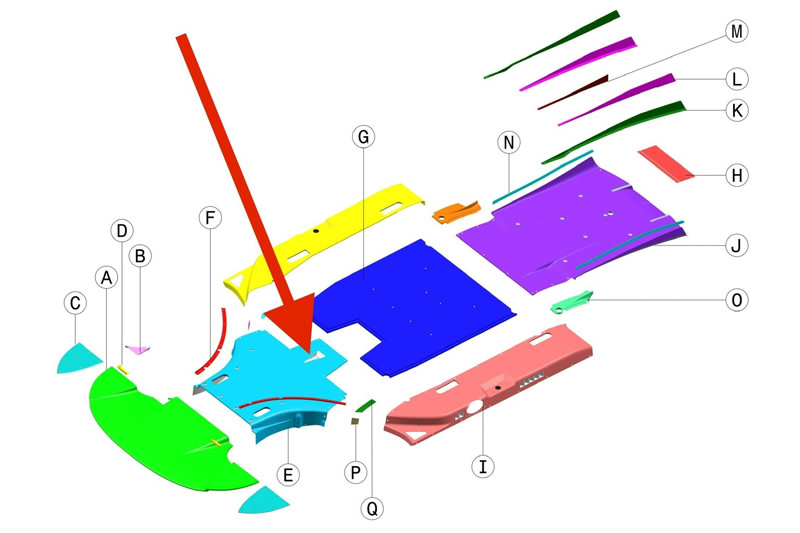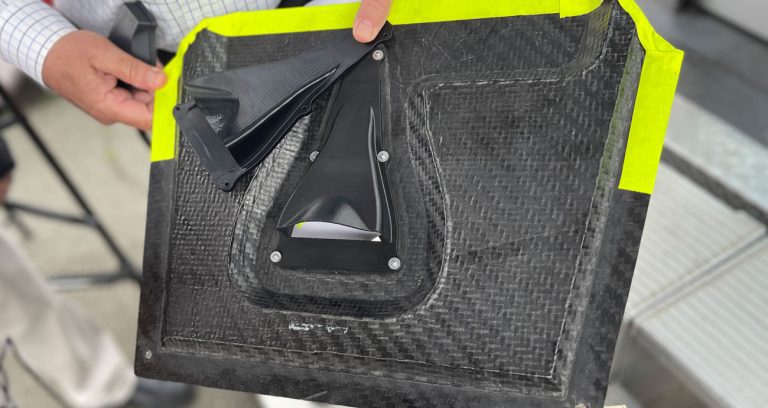NASCAR revived an old policy on Saturday afternoon at Sonoma Raceway when it displayed, for the entire garage to see, the reason the league hammered Stewart-Haas Racing and Chase Briscoe on June 1 with one of the largest penalties in Cup Series history.
Brad Moran, the managing director of the Cup Series, met with media members outside of the series hauler to spotlight an air duct that was illegally counterfeited and installed on the Stewart-Haas No. 14 and found following a teardown inspection at the NASCAR R&D Center in Concord, North Carolina following the Coca-Cola 600.
Related: NASCAR schedule – Races today, this weekend, and how to watch
As a result, Briscoe was docked 100 driver points, his car lost 100 owner points and crew chief Johnny Klausmeier was given a six-race suspension. Stewart-Haas Racing was also hit with a $250,000 fine. At the time, Briscoe fell from 17th in the championship standings — just four points out of a playoff spot — to 31st.
His only pathway to the 10-race playoff format is to win one of the remaining 12 regular season events. But even then, due to a 25-point playoff point deficit, Briscoe would have to win five of the final 12 races just to break even with the winless drivers who qualified for the playoffs.
Thus, Briscoe would have to win a race in all three rounds of the playoffs just to advance to the four-driver championship round in November at Phoenix Raceway, underscoring the severity of the penalty.
Nascar shows off Stewart-Haas Racing’s counterfeit air duct

The second-year Cup Series car is what the industry refers to as a spec car. That means every piece and component must be purchased from an approved single-source supplier. NASCAR discovered that Stewart-Haas Racing had counterfeited the air duct, a part designed to move heat out of the engine, with one produced in-house and penalized them accordingly.
“It was a part that was made, and it was made for whatever reason,” Moran said. “It was, I guess, put on by error but it was on the vehicle. It is a piece that should not have been made in the first place, and it was spotted at our teardown at the R&D Center.”
The components are made to include markings that make them identifiable and Moran displayed how the duct taken from the SHR No. 14 was ‘clearly different’ from one produced by Fibreworks Composites.
“There’s some defects that are built into it that are built into each one as it’s a 3D part,” Moran said. “So, we know what they are and there’s certain little characteristics that are in it. But again, that was after we scanned it and everything. It was a visual that doesn’t look like this (real) part, and then the more we examined it, the more we realized it’s not a part they bought.”

NASCAR developed this generation of cars, in part, to reduce the cost of competition but also to create a more level playing field between the richest and poorest teams down the grid. NASCAR officials routinely speak these days of ‘changing the culture’ of innovation to one of strict adherence to regulations.
“Our message is we’re not going to back down,” Moran said. “It’s been a culture in this garage (to modify parts) for decades. And for us all to be strong and have the racing that we had last year to continue on, we just need to break that habit and start using the parts as they were designed for.”
It used to be the standard operating procedure for NASCAR to display illegal or unapproved parts the weekend after a penalty but got away from it over the past decade until this season. A call for greater transparency led to NASCAR returning to the policy in 2023.
Two-time Cup Series champion Kyle Busch appreciates that transparency but warned that most teams are tampering with spec parts and pieces to some degree.
“I wish we had a ‘what an idiot’ award. I mean even if you can’t find that part, you know you can call one of the other race teams and say ‘Hey, do you guys have this? Can we buy it from you?’ That blows my mind. I don’t get it. For as little as that probably meant, that was a huge fine to the pocketbook and points book.
“But anyways, I think it’s kind of cool that they show all of that stuff; show exactly what’s going on and what guys are doing.
“What’s crazy about it, though, is that all the penalties have come from the R&D center. I guarantee you that you could take 15 (cars) after every single race and there would be something wrong with 14 of them, you know? It’s all the tricks and what you’re trying to do and what you can get away with, all of the time.”
– Kyle Busch
That’s an example of the culture that Moran spoke about, while also pointing out that this isn’t the highest end of the penalties NASCAR could have issued for this type of infraction.
“It was the low end of the L3,” Moran said. “It’s a real big hit for any team. If it continues, and we feel we are not where we need to be, unfortunately, it’s going to ramp up. We’re not going to stop.
“The deal with this car is it needs to be run without modifying. It costs teams a lot of money in development. All the owners agreed. We all agreed where we need to be to make this a successful program, and we’re not going to give up.”
Matt Weaver is a Motorsports Insider for Sportsnaut. Follow him on Twitter.